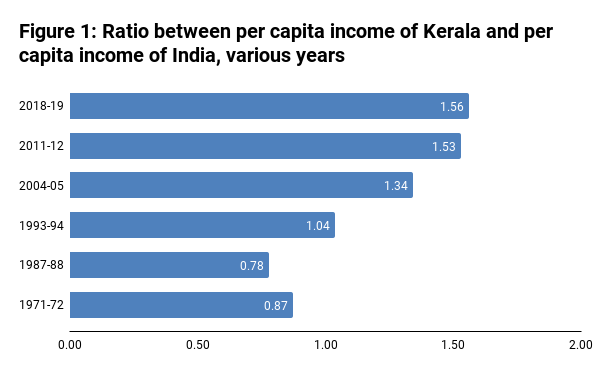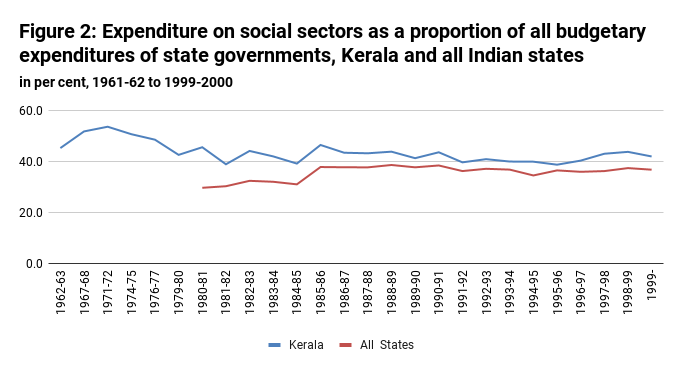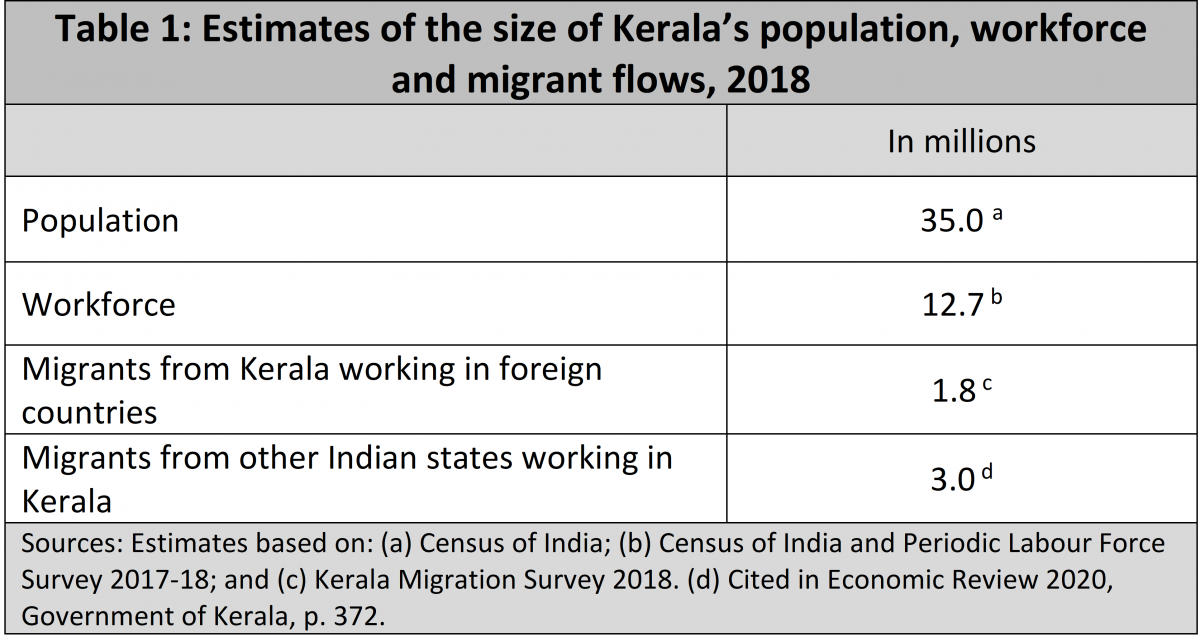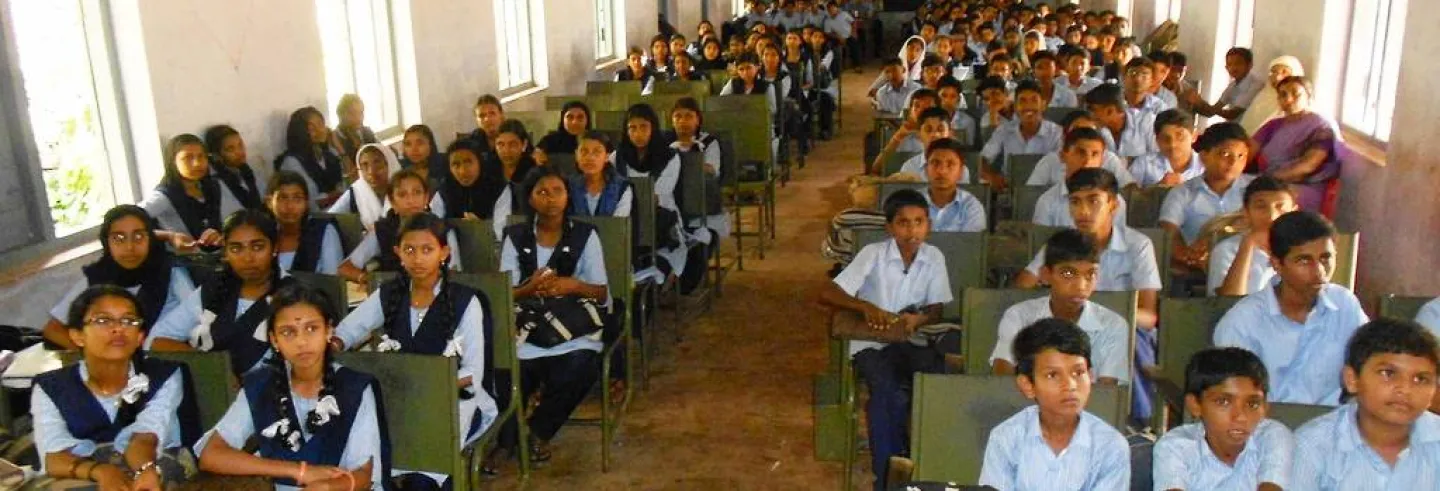At the time Kerala became a state in 1956, it was one of the poorest regions in India. Today it is one of the richest Indian states and also the one that is best placed to achieve developed-country living standards in the near future. Central to this remarkable transformation has been the high level of social expenditure undertaken by state governments in Kerala over the decades. The interventions by the government worked in tandem with the activities of political parties, trade unions, community organisations and the media, richly illustrating the power of public action to bring about development transformation.
By the 1970s itself, Kerala had made commendable progress in the areas of land reform, general education, and public health, and in reducing caste and gender inequalities. These achievements came in spite of the low level of per capita income of the state at that time (see Figure 1). A number of scholarly studies have traced the development journey that Kerala followed (Centre for Development Studies 1977; Jeffrey 1992; Ramachandran 1996; Heller 2000). Some of them even have referred to it as a “model”. Pointing to Kerala’s experience, Amartya Sen argued that the expansion of substantive freedoms—to lead a healthy life, to gain education, and to participate in political discussions—does not have to wait till incomes reach a high level.
Kerala’s economy accelerated in the late 1980s and continues to grow rapidly even today. The Kerala experience distinguishes itself not just because social development preceded economic growth but also because social development provided the stimulus for a faster and qualitatively better economic growth.

Spending on the social sectors
Even before the formation of the state in November 1956, Kerala was ahead of the rest of India in the expansion of literacy, mainly on account of positive interventions by the rulers of Travancore and Cochin.
Within a few weeks after it took office in 1957, the first state government in Kerala took steps for legislative action on land reform and in the area of general education. In the late 1950s, a majority of the schools in Kerala were run by private managements, and teachers received very low salaries alongside no job security. It was in this context that the Kerala Education Bill was introduced in 1957. With this legislation, the state government (even to this day) pays the salaries of teachers of “aided” schools directly and regulates their working conditions. Of course, education is free in government schools (run directly by the government) and government-aided schools across the state. Together, they accounted for 91.9% of all schools in Kerala, and employed close to 150,000 teachers in 2019-20.
The first government in Kerala took a conscious decision to allocate a substantial part of its total spending to education and health.
A remarkable feature of public policy in Kerala has been the importance elected governments have given to human development -- allocating a substantial part of its total spending to education and health (Figure 2). Such high levels of spending on education and health as witnessed in Kerala were unheard of in other Indian states at least until the end of the 1980s. In 1980-81, while social sector expenditure as a proportion of the total budgeted expenditure was 45.7% in Kerala, the average for all Indian states was 29.8%.
The ripple effects caused by the heavy spending on education and health spread wide and lasted long, especially in rural areas. As someone who grew up in Kerala in the hilly district of Idukki during the 1980s, I now realise what a feat public education had achieved in uplifting my generation. Government-run or government-aided schools, which took almost no notice of the class, caste, and religious backgrounds of their wards, set the stage for a momentous social transformation. Teachers—more women than men—were among the prime catalysts of the progressive change while the state government guaranteed their income and dignity (I remember how my late mother’s job as a schoolteacher provided her with a sense of empowerment and agency, that ensured that her voice was heard within the family and outside).
However, questions were raised about the fiscal costs involved in the state’s high social spending (these issues continue to figure prominently in discussions even today). More so in a state that has been experiencing stagnation in industrial investments (Thomas 2005). Further, with positive developments in the social sphere, the wage rates of Kerala’s casual workers, including agricultural workers and manual workers, rose to the highest level in the country. Critics argued that the relatively high wages made the agricultural and industrial sectors in Kerala less competitive.

Demand-led economic growth
Though Kerala’s per capita income was 20% less than the average per capita income of India in 1987-88, it rose to a level equal to the national average by 1993-94. The state’s per capita income climbed to even higher levels in later years—in 2004-05, it was 30% higher and by 2017-18, it was 60% higher (Figure 1).
Two factors stand out behind the acceleration in income growth in Kerala. One, the emergence of broad-based domestic demand in the state, coming as it does from various classes of people, and fuelled by consumption expenditure. Two, the investments Kerala made in human capital began to bear fruit, especially after the 1990s.
The combined average annual rate of growth of incomes from the service and construction sectors in Kerala has been at around 8% for three decades now.
The revival in income growth in Kerala since the late 1980s has been led by the service and construction sectors, and to a lesser extent, manufacturing—all of these driven largely by domestic demand. The combined average annual rate of growth of incomes from the service and construction sectors in Kerala has been at around 8% for three decades now, starting from 1988-89. Transport, communication, banking and financial services, and social services, including health and education, have been some of the other major growth areas. A number of factors have helped to energise domestic demand in Kerala, including the relatively high incomes offered by agriculture, dominated as it is by commercial crops such as coconut and rubber. Another factor that has been very important is the remittance income sent to the state by migrant workers.
The high level of wages received by casual workers in Kerala has positively contributed to the growth process. They ensure that the gains from economic growth have been spread more equally and that demand comes as much from the poor as the rich. Kerala has been way ahead of other Indian states in paying high daily real wages to casual workers in rural areas. The average daily wage of rural casual workers in Kerala was more than double (2.3 times) the national average in 1983 and a little less than double (1.9 times) in 2017-18. 1 As per estimates based on the National Sample Surveys on Employment and Unemployment in India and the Periodic Labour Force Survey (2017-18). Disparities between formal and informal sector workers in wages and working conditions are much less pronounced in Kerala than the rest of India.
The high wages have translated into high levels of consumption expenditure and stimulated Kerala’s economic growth. Compared to the corresponding average levels for rural India, household per capita consumption expenditure in rural Kerala was lower than the national average in 1970-71, 3% higher in 1989-90, 56% higher in 1999-2000, and 87% higher in 2011-12. 2 As per estimates based on the National Sample Surveys on Household Consumer Expenditure in India, various issues.
Reserves of talent
The second factor behind Kerala’s economic resurgence has been its reserve of human capital—a factor that has been becoming increasingly crucial over the years. Workers from Kerala were among the first to seize the employment opportunities that were opened up in the oil-rich countries in the Middle East from the 1970s onwards. Putting together evidence from various sources, we find that as many as a million people from Kerala migrated out of the country during the 1980s and 1990s, a vast majority of them as workers in the Gulf countries (the various rounds of the Kerala migration surveys are an important source of information. See Rajan and Zachariah 2019). During these two decades, international migrants from the state would have constituted as much as a fifth of Kerala’s entire increase in the working age population (which was 5.6 million).
The remittances sent by the migrant workers to their families as a proportion of the net state domestic product of Kerala ranged between 20% and 25% for two decades from the mid-1990s onwards. This may have declined slightly over the last few years following the shrinking of job opportunities in Gulf countries. Remittances, of course, are not a part of domestic incomes. However, they provide a boost to consumption and investment, and thereby, positively influence economic growth.
Kerala continues to be much better prepared than the rest of the country to take advantage of the opportunities offered by globalisation and new technologies.
The deep reserves of talent that Kerala possesses have turned out to be a big asset for the state’s economic growth, especially from the 1990s. With the foundation it has built in public education and public health, Kerala was (and continues to be) much better prepared than the rest of the country to take advantage of the opportunities offered by globalisation and new technologies.
When I joined the Government College of Engineering in Thiruvananthapuram as an undergraduate in the early 1990s, what was uppermost in my mind was whether I would be able to find a job—any job—after graduation. . Fortunately for us students , our career prospects appeared much brighter by the time we were ready to graduate. India’s information technology (IT) revolution was beginning to take wing and the Kerala government inaugurated the first information technology park in the country in Thiruvananthapuram in 1995 (this Technopark remains one of India’s largest, and employs more than 60,000 professionals today).
Studies suggest that in 2018 there were approximately 1.8 million people from Kerala working abroad, including the United States, United Kingdom, and the Gulf countries (Table 1). Approximately one-third to one-half of all international workers from Kerala are high-skilled professionals, including nurses, engineers, doctors, administrators, and media workers, while the remaining are engaged in medium-skilled jobs such as salespersons, mechanics and drivers (Rajan and Zachariah 2019). If we also include professionals working in other Indian states, there is likely to be between one and one and a half million from Kerala who have managed to find high-skilled jobs outside the state.

Achievements in education and health provided the base for a positive shift in the nature of economic activities and entrepreneurship that emerged in Kerala in the 1990s. Today, Kerala is well recognised as a major player in the tourism and IT sectors. It is less known, however, that Kerala is also making its mark as a location for a broad range of innovative industries—casting aside its earlier image of a state that is not industry friendly. One of Asia’s leading medical device firms (manufacturing blood bags) operates from Thiruvananthapuram, set up in 1983 by a Malayali (C. Balagopal, who quit the civil service to become an entrepreneur). The state-funded Sree Chitra Tirunal Institute for Medical Sciences and Technology in Thiruvananthapuram supplied the technological know-how for launching this enterprise. According to the latest ranking announced by the Union Government, Kerala is among the top three performers in the country when it comes to providing a good ecosystem for start-up businesses.
Coping with new challenges
As Kerala enters the third decade of the 21st century, it faces a unique set of challenges. The size of the working age population in Kerala is set to decline between now and 2031—almost two decades before such a decline is to be registered at the national level. While the state has to grapple with the problem of an ageing population, it also has to guard itself against a regressive slide into inequality. Kerala has to seek new sources of economic growth in sectors that can meet the job aspirations of educated citizens of the state. At the same time, many sectors of Kerala’s economy report labour shortages, especially of manual and less-skilled workers.
While the inclusive nature of development in Kerala has benefited everyone, including communities and groups that faced historic disadvantages, the gains of education have not been evenly distributed. In particular, people belonging to the Scheduled Tribes, the Scheduled Castes and the fishing communities have lagged behind the rest in educational and professional attainments.
In Kerala, the labour force participation rate (LFPR) of females is low—31.9% compared with 78.9% for men. But the female LFPR in Kerala is better than the national figure (25.3%; figures for 2017-18, for population in the age group of 15-59 years). This is despite that, in Kerala, female workers outnumber male workers in health and education, and have a significant presence in some other sectors too, such as public administration and professional services. Women from Kerala have also migrated in large numbers for employment— notably as nurses—to other states of India and to foreign countries.
Kerala is not generating an adequate number of job opportunities for the educated, especially regular jobs that can provide decent incomes.
The low female LFPR in Kerala, despite the progress achieved by the state in many gender-related aspects of development, highlights two important issues. First, the state is not generating an adequate number of job opportunities for the educated, especially regular jobs that can provide decent incomes. The “discouragement effect” that this may have created in the labour market has been particularly severe on women. Second, gender-based disparities continue to exist in Kerala at the workplace, as they do within families and in society at large (Eapen and Kodoth 2002).
Workers who are short-term migrants from states such as Assam, West Bengal, Odisha, Bihar, and Uttar Pradesh fill the gaps in Kerala’s labour market, mainly as casual workers in construction and manufacturing, and also, increasingly, in selected service sectors such as in restaurants, hair-cutting saloons, and beauty parlours. Estimates suggest that the size of this migrant workforce in Kerala could be as large as three million. Migrant workers in Kerala in the construction sector earn as much as Rs.1,000 a day, almost twice the corresponding wage rate in, say, Delhi.
An agenda for the future
In response to the emerging challenges, Kerala has taken steps to deepen the gains of social development and to broaden their reach. The state government has invested in new-generation public schools over the last few years, and, as a result, enrolment in government schools went up significantly after 2017-18. The quiet determination with which the public health system in Kerala fought off—the Nipah virus in 2018 and is currently fighting the Covid-19 pandemic has earned it respect worldwide. Among the high points in Kerala’s fight against the Covid-19 pandemic have been interventions made by the state government to protect lives and livelihoods. “No one should go hungry” became the battle cry of the administration and civil society alike during the lockdown periods (just as it had been in the wake of floods in August 2018).
Kerala sees future growth possibilities in healthcare, life sciences, biotechnology, pharmaceuticals, space and aeronautics, and AI.
Kerala faces immense challenges in transforming itself into a modern economy. The possibilities for knowledge-led economic growth in the state were outlined in the "Kerala Looks Ahead" conference (organised by the Kerala State Planning Board in February 2021) and the budget for the state government (presented in January 2021 by then Finance Minister T M Thomas Isaac). Some of the sectors in which Kerala sees future growth possibilities include healthcare, life sciences, biotechnology, pharmaceuticals, space and aeronautical technologies, and artificial intelligence (KSPB 2020). The state also has to fully tap into its enormous potential in agriculture and agro-processing industries, as well as in petrochemical industries, port-based industries, ship building and logistics (Kerala is among the few states in India with four international airports and two major seaports).
An important agent of knowledge-driven economic growth in Kerala will be its universities and other academic and research institutions. Therefore, upgrading their capabilities will be a key policy priority. Kerala will have to draw on the talents of its youth coming out of higher education centres (166,000 enroll for tertiary education in the state every year, including 60,000 in engineering courses) as well as on its diaspora of high-skilled professionals worldwide.
The limited financial autonomy of the state government remains an important hurdle. This is mainly because of the nature of federal fiscal relations in the country with the Central government holding the power to collect a majority of the tax revenue. In 2019-20, the state’s own tax revenue as a proportion of gross state domestic product was only 6.4%. Kerala will have to build institutions that can help mobilise the considerably large savings in its economy into investments that are needed for its future growth.
The Kerala experience points to the hollowness of the argument that government spending slows down economic growth.
The freedoms and the relatively high standard of living that the people of Kerala enjoy today have been the result of decades of public action, set in motion by progressive social and political formations in the state. They have also been the result of the high level of social sector spending by state governments from the 1960s onwards. The Kerala experience points to the hollowness of the argument—reiterated time and again in India and other parts of the world—that government spending slows down economic growth. A related lesson from Kerala is on the role of wages. Rather than hurting the economy, higher wages for informal workers can help broad-base demand and speed up economic growth.
There are expectations that Kerala is now set to make a big leap in economic growth, building on its stock of human capital and the fund of goodwill it has accumulated over the years, while also making use of the opportunities available in this era of new technologies. Living up to these expectations will be a tall order for the Left Front Government in the state that has been re-elected for a second five-year term.








